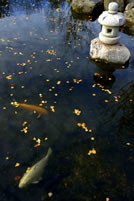

Martial Art as a Spiritual Practise (2) |
 Today most martial arts training begins once a person has been accepted into a martial arts school called dojo (Japanese), dojang (Korean) and kwoon (Chinese), all three terms translate as "Place of Enlightenment" (Hyams, 1979, p. 4). Depending on the style, training usually begins by learning the basic movements of the art e.g. fighting stance, movement, falling, rolling, basic punching, kicking and/or throwing. The student learns that these techniques contain a lot of naturally condensed movement that requires balance, concentration and focus. To fully understand them s/he must acquire an eye for differentiating natural movement in all living things (Lee, 1975). This is because the martial movements must be natural; they are the fighting movements of the human animal and must therefore be completely instinctive in perfection. All humans will instinctively recognise a true martial arts master by the way he moves. He will possess stillness in movement; each step will be like the flow of water - effortless.
Today most martial arts training begins once a person has been accepted into a martial arts school called dojo (Japanese), dojang (Korean) and kwoon (Chinese), all three terms translate as "Place of Enlightenment" (Hyams, 1979, p. 4). Depending on the style, training usually begins by learning the basic movements of the art e.g. fighting stance, movement, falling, rolling, basic punching, kicking and/or throwing. The student learns that these techniques contain a lot of naturally condensed movement that requires balance, concentration and focus. To fully understand them s/he must acquire an eye for differentiating natural movement in all living things (Lee, 1975). This is because the martial movements must be natural; they are the fighting movements of the human animal and must therefore be completely instinctive in perfection. All humans will instinctively recognise a true martial arts master by the way he moves. He will possess stillness in movement; each step will be like the flow of water - effortless.
This process throws the practitioners into the first stage of inner conflict, their bodies fight to maintain the poor movement and posture they have acquired during their lives. They (the martial arts) incorporate countless discoveries about our psychophysical potential, which is apparent in the fact that many of them use methods that modern somatic disciplines have only recently discovered... they promote alignment and extension of the neck like the Alexander Technique, and cultivate the soft pleasurable stretching of the Feldenkrais Method (Murphy, 1992, p. 458).
Once the student comes to terms with this conflict s/he can move on to further challenges in training. Examples of these are facing opponents in combat, learning to breathe correctly in movement, practising moving meditation, learning visualisation and cultivating chi (internal energy).
At the highest levels of training practitioners have been known to perform incredible feats, such as catching an arrow in mid-flight and doing hand stands on one finger. After many years of practice and meditation masters have been known to be able to knock a person down simply by projecting their energy through them, or crush a glass in one hand without squeezing it. The ability to sense fine shadings of atmosphere, the faint rustling of leaves and grass, the murmuring of insects, or the distant sounds of human movement become natural (Murphy, 1992, p. 453). Masters often experience telepathy and other extrasensory abilities. Murphy (1992) explains that when the mind is freed from distracting thoughts, the senses function with new scope and clarity, and when ones achieves this mental stillness, extrasensory capacities emerge (pp. 453-454).
There is a famous oral legend in the martial arts that tells of a student who walked with his master in the forest. Suddenly the master grabbed his foot as he was about to step on a grasshopper hidden in the thick foliage. The student asked, "Master how is it that you heard the grasshopper?” the Master answered, "How is it you did not?"
It is important to understand that the object of training is not the acquisition of these powerful abilities, they are simply by-products of the greater process of becoming whole - merging with the Tai Chi (the Grand Ultimate cosmic source).
Training leads the students to face themselves in conflict. In the "Place of Enlightenment" we place ourselves in situations of inner struggle where we look down the throat of annihilation, it is then that we are at our most primitive, and it is then that we must face ourselves in truth, confront our fears and trust our instincts. When we can come through that experience in such a way that we would welcome it should it appear again then we will have transcended conflict and truly touched the Tai Chi.
For Part 3 Click here


Home | Fanchento | Federation | News | Articles | Products | Links |

